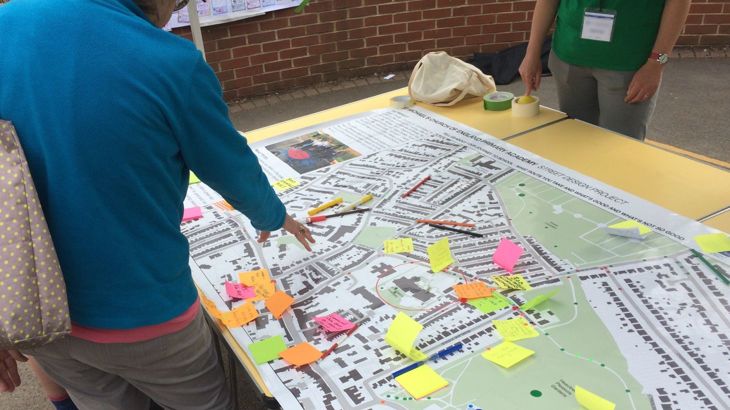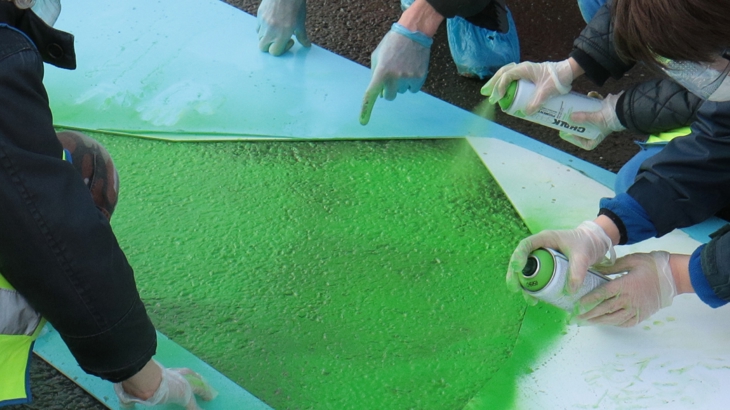Safety is a significant issue on UK roads, particularly during the school run. Together with Road Safety Trust, Sustrans explored the impact of light-touch interventions in reducing dangerous road behaviours outside a school in Exeter, aiming to create a safer space for walking, wheeling and cycling.

A traffic calming dragon has been installed outside a school in Exeter, helping to investigate the impact of light-touch interventions on road safety.
The project focused on designing small interventions to change the feel of the carriageway outside the school to make it more attractive and less car-dominated.
This would raise awareness of the ‘school zone’ and address road safety concerns that are stopping families from choosing an active school run.
A traffic calming dragon was designed with a school in Exeter, aiming to create a safer space for walking, wheeling and cycling to school.
The learning from this project was developed into a toolkit for schools and local authorities.
The importance of feeling safe on the school run
Feeling safe is key for families when travelling to and from school each day.
Gridlock, air pollution, inconsiderate parking and dangerous manoeuvring are common issues outside schools.
This creates a stressful and unpleasant environment for everyone involved, whether they are on foot, on bikes, or in cars.
Because of this families often opt for the perceived ‘safer’ option of the car, missing out on the many benefits of being active each day and further compounding the problem outside schools.
Teaming up to investigate light-touch measures
With funding from the Road Safety Trust and Devon County Council (DCC), we were able to investigate the impact of small changes that schools and local authorities could implement to improve the situation.
Our School Officers, who have been working with selected schools in Devon for many years, teamed up with our Design and Engineering team, DCC Highways Engineers, St Michaels' C of E Primary Academy in Exeter and its local community to answer a question: Does light-touch traffic calming have an impact on dangerous road behaviours outside schools?
The first step was to identify the existing road safety concerns that were stopping more people from choosing an active school run.
Using these, we explored light-touch interventions that could help.
Empowering the school community
In June 2018, we hosted a series of collaborative workshops for pupils, codesign sessions for families, discussions with residents, as well as engaging with nearby organisations.
A collaborative approach to this project allowed the wider school community to take ownership of the process, making sure that the varying barriers, wants and needs were taken into account.
As a result, all ages were empowered to raise ambitions and influence change in their local communities.
Discovering the day-to-day issues
The first session explored perceived issues and barriers, as well as the positive elements of active travel outside the school.

Large scale maps of the area were used, enabling people to highlight and feedback on specific issues and opportunities.
Pupils also did an on-street survey highlighting the good and bad points outside the school.
Key issues and barriers included:
- cars not slowing or stopping when approaching a crossing point,
- vehicle speeds,
- anti-social parking,
- air quality concerns.
Traffic speed, volume count, and road user behaviour were tracked outside the school.
The results confirmed the concerns raised by the school community.
Designing a solution
In the second session, the children and the wider school community were tasked with coming up with solutions.
Participants experimented with colour, greenery, patterns and signage to brighten the space outside the school and create a ‘school zone’.
One design featured a dragon on the roadway. It tied in with the school's name, which referred to the biblical tale of St. Michael and the dragon.
Using the dragon design would act as a speed calming measure and make drivers aware that they are entering a school zone.
This would make the space safer for school children, their families, and other street users.
The designs from the workshop were developed by our Design and Engineering team.
Trialling the dragon
The dragon design was tested during a trial event.
A smaller-scale version of the dragon was temporarily painted on the road during a community-led event by the school children, staff and parents involved in the project.

The design was trialed at a community-led event, inviting those involved in the project to paint the design on the road during a temporary closure.
The traffic calming dragon is installed
The design was finalised following feedback from the local community and safety and highways assessments by DCC.
Installation was delayed due to the COVID-19 lockdown but the permanent thermoplastic design was safely installed in August 2020.
The results
Our Research and Monitoring team returned in May 2021 to monitor the impact of the dragon design.
Overall the results show light-touch interventions like this road design have a considerable impact on certain road safety characteristics.
We found that:
- Traffic volume decreased on weekdays from 3,366 to 2,642 vehicles.
- The decrease in traffic volume led to no change in the proportion of vehicles speeding (34.6% to 33.95%).
- The number of vehicles yielding to allow parents and children to cross the road increased from 46 yields out of 794 yielding situations, to 48 out of 420.
We found that parents’ perception of the attractiveness of the street increased and that stakeholders felt empowered, but this was accompanied by a mixed response towards the perceptions of safety.
And alongside the mostly positive findings about traffic behaviour outside of the school, 82% of survey respondents supported installing light-touch measures.
Sharing our findings with schools and local authorities
Using the findings of the dragon installation, we developed a toolkit designed to support school communities in making their streets safer and healthier.
The toolkit is also designed to support local authorities who want to engage communities in the development and improvement of streets around schools.






